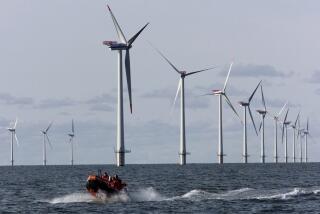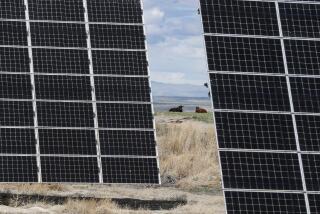Danes See a Breezy Solution
- Share via
COPENHAGEN — A graceful arc of alabaster windmills rises out of the midnight-blue waters of the Oresund strait, visual testimony to Danes’ commitment to clean energy and the health of the planet.
Until recently, wind parks were also sources of bitter resentment among those who saw the stark white poles, whining turbines and jerky rotors as a blight on their bucolic landscape.
But beauty is in the eye of not only the beholder but also the shareholder.
As Europe embarks on a major push to reduce carbon dioxide emissions, the Danes simultaneously have discovered how to reduce public opposition to wind parks: They are organizing local residents into investor co-ops so that the pinwheel vistas they gaze upon are their own proud--and profitable--projects.
“To create this enormous wind park right at the doorstep of Copenhagen, well, it’s just beautiful,” enthuses Erik Christiansen, a clean-energy consultant and private investor in the Middelgrunden park in Oresund. “It looks even better when you think that it’s putting money in your pocket.”
The Danes are pioneers in creating offshore wind installations like Middelgrunden, as well as one along the gusty shores of Aarhus and two more to come next year in the North and Baltic seas. Germany also plans the first two in a spree of offshore installations by the end of 2002.
Offshore wind is suddenly the showcase project of Northern European countries seeking to meet carbon dioxide reduction targets set by the 1997 Kyoto climate treaty negotiated in Japan. CO2, produced when fossil fuels are burned, is considered a leading cause of global warming.
The effort is also getting an unexpected moral tail wind from the Bush administration’s decision to pull out of the accord in favor of further study. Those in the renewable-energy sector are galvanized to show that cleaning up is not just lofty but lucrative.
“There was a huge feeling of disappointment here in Denmark and throughout Europe when the richest country in the world and the country contributing the most emissions said it couldn’t afford to meet its Kyoto obligations,” said Turb Falbe Hansen, senior information office for the Ministry of Environment and Energy.
But now Danes are driven to corner the wind technology market worldwide at the same time they surpass their own CO2 reduction targets, he said. Already by far the world leader in per capita wind power, Denmark has the capacity to produce 2,364 megawatts--that’s 450 watts per capita, in contrast with 9 for each U.S. citizen. The Danes plan to generate 1,500 more megawatts by 2010.
Neighboring Germany’s windmills produce 6,400 megawatts. If relocated to California, that would be enough to light about 4.8 million homes. Germany accounts for more than one-third of all wind power in the world. Spain surged into second place last year, nearly doubling its output to 2,538 megawatts. The United States runs a close third, with 2,495 megawatts. U.S. production stagnated over the past decade, although an estimated $1.5 billion is expected to be invested this year, double the previous highest annual investment in wind power.
In the early 1980s, California accounted for 95% of the world’s wind generation, but the state has failed since then to keep pace with Western Europe. There have been no serious proposals for offshore wind parks.
Paul Gipe, a leading American expert on wind power, says he wouldn’t rule out future offshore development in California, but he is generally disparaging about the state’s recent efforts. The state now gets little more than 1% of its energy from wind power--far more than any other state but paltry compared with Denmark.
A full 13% of Denmark’s electricity comes from the wind, and the country expects to generate enough renewable power to account for 23% of its energy needs within two years and 50% by 2030, mostly from wind.
Wind accounts for a paltry 2.5% of German energy at the moment, but wind power has been developed there for only a decade. It got a jump-start from a 1991 law guaranteeing generous compensation for all producers feeding into the national electrical grid.
Government incentives in Germany and renewable energy credits in Denmark promise to make wind power economically viable for producers for now. Eventually, fossil fuel prices are expected to be much higher, making windmills much more competitive.
“Wind is the most important form of energy development in Germany because we don’t have much hydro potential and nuclear power is being shut down,” said Wolfhart Duerrschmidt, head of the Environment Ministry’s section that handles renewable resources. Only 3.5% comes from hydro, and the country’s 19 nuclear plants supplying a third of power demand are being phased out over the next two decades under pressure from a broadly anti-nuclear public.
Still, Germany is so densely populated that many residents oppose more wind parks inland, pressuring developers to move offshore, as they have in Denmark. If all goes well with next year’s pilot projects, such installations could lift the wind-generated share to 20% by 2020 and 50% by 2050, Duerrschmidt said.
Germany’s offshore prospects are more limited than in Denmark because most of its coastal waters are designated nature preserves. Construction is forbidden in the Wattenmeer region extending seven miles from the northern coastline. Germany’s national economic zone stretches an additional six miles, providing good wind park venues for catching the North Sea’s powerful gusts. But the cost of running submerged transmission lines to a land-based power grid could add 60% to the construction cost, raising the risks for investors. On the other hand, offshore winds are more powerful, promising to double a land-based windmill’s electrical output.
“Offshore development is more complicated because of the distances we would have to go to to get beyond the protected coastline, but the technology is being mastered quickly. Every year we get bigger turbines that produce more electricity for less investment,” said Jens Peter Molly, director of the German Wind Energy Institute in Wilhelmshaven. He said Germany’s wind capacity is to double from 6,000 to 12,000 megawatts in five years and rise to 20,000 megawatts within a decade.
While Germany has concentrated on building a lot of small wind parks, to avoid provoking a loud public outcry, Spain--the fastest-growing wind power on the continent last year--has shown that fewer but bigger parks can also be a solution, Molly said.
Fears have been expressed that offshore parks could pose a hazard to navigation or aircraft. But Germanischer Lloyd of Hamburg, which sets technical certification standards for wind parks, says aviation corridors are higher than the windmills and the parks’ stationary locations can be clearly marked on nautical charts. “There’s more risk of running into another ship than a windmill,” said the company’s director, Bernhard Richter.
Greenpeace, which supports the wind parks, embarked last month on a summerlong tour of German coastal communities to conduct informational town hall meetings. The hearts-and-minds campaign aims to overcome the NIMBY--”not in my back yard”--factor as well as unite environmental groups on the issue. Some fear negative ecological side effects from offshore construction, such as seabed disruption and noise pollution that could disturb marine life.
“Our job is to take care that the technology develops in an ecologically acceptable way,” said Sven Teske, an environmental engineer with Greenpeace in Hamburg. “We recognize that we live in an industrialized country that needs energy and we can’t be opposed to everything--nuclear, coal and wind.”
The effort in Germany is making for strange bedfellows. Greenpeace and other conservation groups are partnering with the likes of Shell Oil and electrical producers currently focused on nuclear power generation. Their aim is to more than triple Germany’s use of renewables--from less than 3% now to 10% by 2010--to meet the country’s energy needs.
With financial incentives and moral support--if not actual subsidies--from the federal government in Berlin, the German wind sector is booming. More than 30,000 jobs have been created in the country as private firms building rotors, towers, transfer stations and ever more powerful turbines have sprung up across wind-rich coastal states. Schleswig-Holstein state, straddling the North and Baltic seas, already produces nearly 25% of its electricity from windmills, and the industry is now the state’s second-most important after tourism.
“We are bracing for an insane boom in offshore construction,” said Richter of Germanischer Lloyd. “The opposition inland is growing. This is a densely populated country--we can’t do a Palm Springs kind of buildup here.”
Turbine manufacturers like Pro & Pro of Rendsburg, in Schleswig-Holstein, are inundated with construction orders and struggling to manage their own growth. The company is working on a 5-megawatt turbine for offshore use--double the size of today’s biggest units--and hopes to have a pilot project in operation by the end of next year, said offshore manager Jens Goesswein. Germany has proposals for projects that would generate 12,000 megawatts offshore--which would triple the existing national wind capacity.
“The potential is tremendous. Europe-wide, there is at least in theory the possibility of supplying 160% of electrical needs from offshore wind parks,” Goesswein says. Worldwide, offshore wind could generate 2.6 times the global energy demand, he adds.
Like others in the industry, Goesswein preaches the virtues of wind generation as the moral high road Europeans are determined to take to meet Kyoto commitments.
“At first the U.S. decision was a shock and there were fears that others might do the same,” he says. “But now I think everyone feels they have even more reason to stick with this objective. We want to show that it’s not just the right thing to do but that it can be profitable as well. We believe we can bring the United States into the boat by the power of a positive example.”
One complaint Danes have about wind power is the excess capacity it provides. Peak wind periods don’t always coincide with demand, compelling grid operators to export surplus electricity to the European mainland for less than it costs to produce.
To tackle the problem, engineers are developing storage capabilities, said Inga Thorup Madsen, head of the Danish Energy Ministry’s wind sector.
Some companies are working to soothe public resistance by experimenting with windmill appearance. Market leader Enercon of Aurich, Germany, for instance, has begun painting towers a pale green at the base that fades to light gray around the turbine and rotors, approximating the natural colors of the horizon.
“At the end of the day, people’s attitudes are based on what they look like,” Teske said of the windmills.
(BEGIN TEXT OF INFOBOX / INFOGRAPHIC)
World Leaders in Wind Power
*--*
Nations with the most wind power capacity Megawatts Germany 6,400 Spain 2,538 U.S. 2,495 Denmark 2,364 India 1,138 Netherlands 449 Italy 427 Britain 406 China 316 Sweden 241
*--*
*
Leaders by per capita wattage
Denmark: 450
Germany: 75
Spain: 64
Luxembourg: 35
Ireland: 35
Netherlands: 29
Italy: 27
Britain: 21
China: 14
Sweden: 10
Source: German Ministry for Energy and Environment
*
Times staff writer Mitchell Landsberg in Los Angeles contributed to this report.
More to Read
Sign up for Essential California
The most important California stories and recommendations in your inbox every morning.
You may occasionally receive promotional content from the Los Angeles Times.














